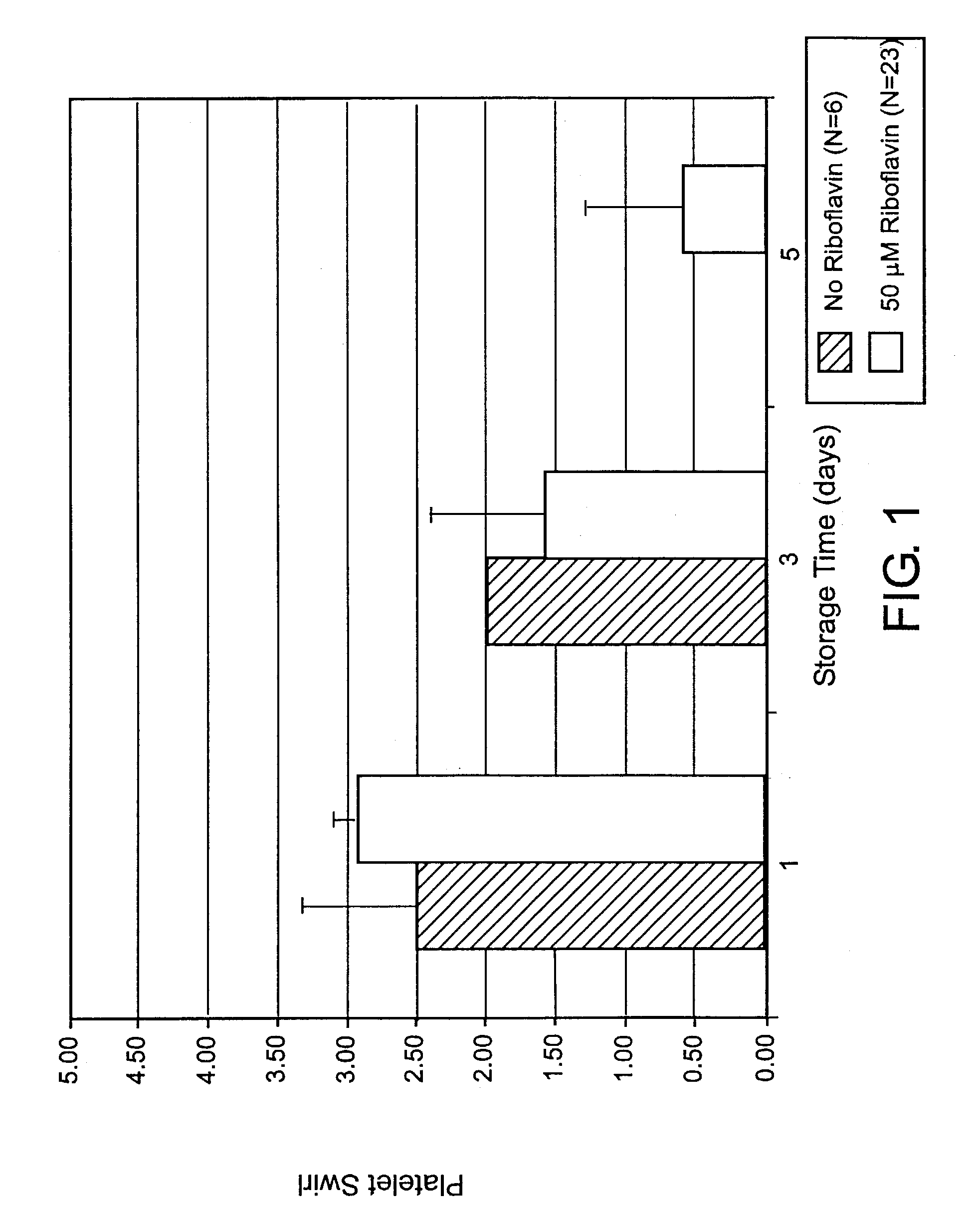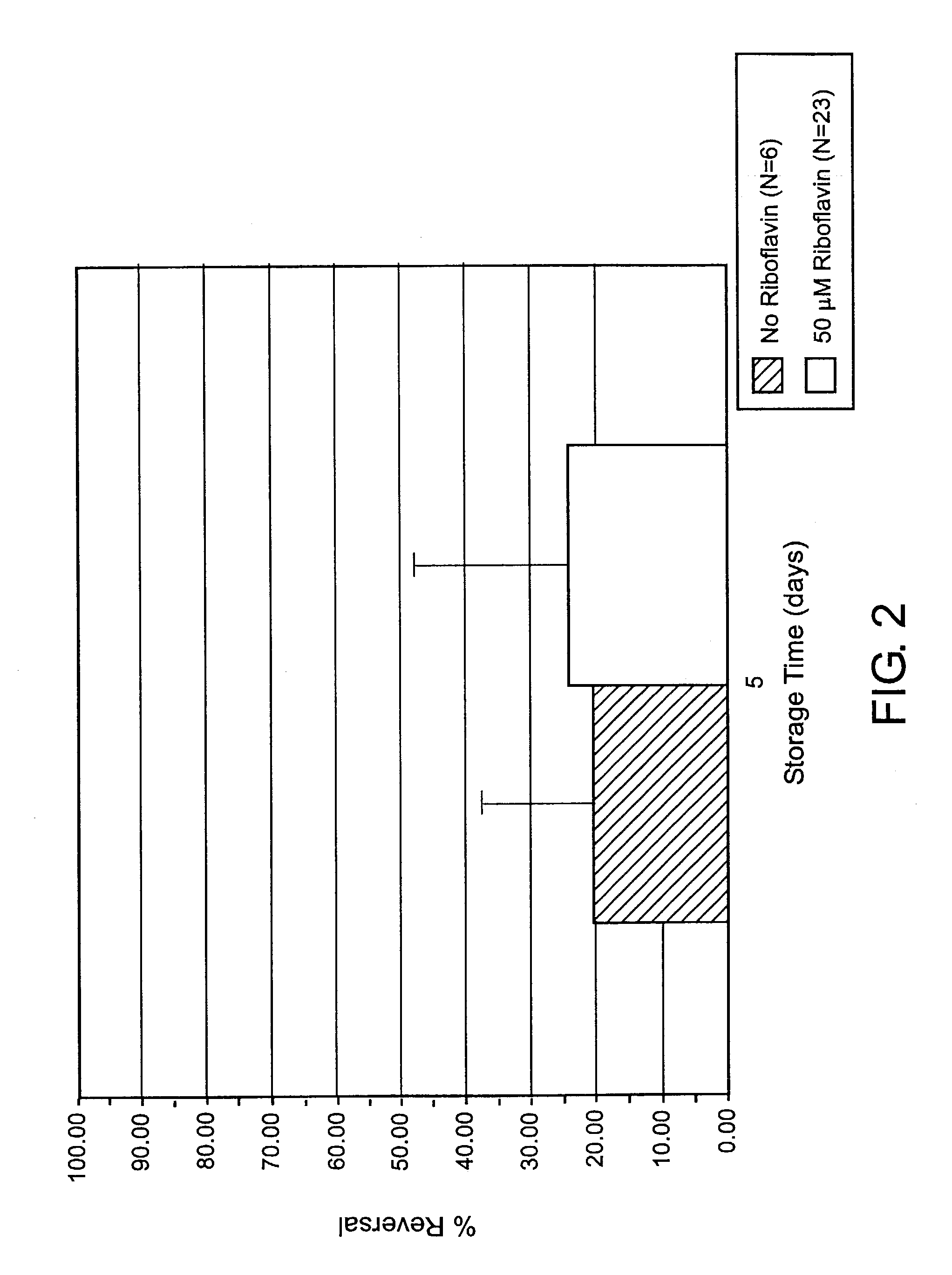Method for preventing damage to or rejuvenating a cellular blood component using mitochondrial enhancer
a technology of mitochondrial enhancer and cellular blood, which is applied in the direction of biocide, other blood circulation devices, organic chemistry, etc., can solve the problems of blood supply contamination with infectious microorganisms such as malaria, west nile virus, hiv, etc., and achieves the effects of reducing the rate of lactate production, increasing oxygen consumption, and increasing the hypotonic shock respons
- Summary
- Abstract
- Description
- Claims
- Application Information
AI Technical Summary
Benefits of technology
Problems solved by technology
Method used
Image
Examples
example 1
Treatment of Platelets with Riboflavin
[0118]Platelets were collected using standard collection methods using a COBE® Spectra™ apheresis machine (manufactured by Gambro BCT, Lakewood, Colo., USA). Fresh platelets were less than 24 hours old after collection via apheresis. Other apheresis machines useful for collecting transfusion-quality platelets are useful in the practice of this invention. Collected platelets were diluted in a solution containing 0.9% sodium chloride with either 0 or 10 μM riboflavin. Samples were saturated with air via vigorous mixing. Platelets were exposed to no photoradiation greater than ambient light. Results are shown in Table 1.
[0119]
TABLE 1O2ConsumptionLactateGlucose(μM / hr / 1012RiboflavinPhotoradiationProductionConsumptionplts)pHConcentrationEUVEVISRateRateDayDay(μM)J / cm2J / cm2(μM / hr)(μM / hr)024 hrs00003118921141000291913612400050876.921000681866.91
Cell quality indicators were improved or unaffected by the addition of riboflavin.
example 2
Treatment of Platelets with Riboflavin and Visible Light
[0120]Platelets were collected using standard collection methods using a COBE® Spectra™ apheresis system (manufactured by Gambro BCT, Lakewood, Colo., USA) and TRIMA® apheresis system (available from Gambro BCT, Lakewood, Colo., USA). Fresh platelets were less than 24 hours old after collection via apheresis. Other apheresis machines useful for collecting transfusion-quality platelets are useful in the practice of this invention. Collected platelets were diluted in a solution containing 0.9% sodium chloride with either 0 or 10 μM riboflavin. Samples were saturated with air via vigorous mixing. The samples were irradiated with a Dymax light source using one bulb at 15.5 mW / cm2 for varying times. The UV component of the light was filtered out using a polycarbonate filter. Exposure time was 31 minutes. Results are shown in Table 2.
[0121]
TABLE 2O2ConsumptionLactateGlucose(μM / hr / 1012RiboflavinPhotoradiationProductionConsumptionplts)...
example 3
Treatment of Platelets with Riboflavin and Ultraviolet and Visible Light
[0122]Platelets were collected using standard collection methods using a COBE® Spectra™ apheresis machine (manufactured by Gambro BCT, Lakewood, Colo., USA). Fresh platelets were less than 24 hours old after collection via apheresis. Other apheresis machines useful for collecting transfusion-quality platelets are useful in the practice of this invention. Collected platelets were diluted in a solution containing 0.9% sodium chloride with either 0 or 10 μM riboflavin. Samples were saturated with air via vigorous mixing. The samples were irradiated with a Dymax light source using one bulb at 15.5 mW / cm2 for varying times. Results are shown in Tables 3 and 4.
[0123]
TABLE 3O2ConsumptionLactateGlucose(μM / hr / 1012RiboflavinPhotoradiationProductionConsumptionplts)pHConcentrationEUVEVISRateRateDayDay(μM)J / cm2J / cm2(μM / hr)(μM / hr)024 hrs002940327115200102940603955111
When riboflavin was added, lactate production rate was decre...
PUM
| Property | Measurement | Unit |
|---|---|---|
| Fraction | aaaaa | aaaaa |
| Fraction | aaaaa | aaaaa |
| Time | aaaaa | aaaaa |
Abstract
Description
Claims
Application Information
 Login to View More
Login to View More - R&D
- Intellectual Property
- Life Sciences
- Materials
- Tech Scout
- Unparalleled Data Quality
- Higher Quality Content
- 60% Fewer Hallucinations
Browse by: Latest US Patents, China's latest patents, Technical Efficacy Thesaurus, Application Domain, Technology Topic, Popular Technical Reports.
© 2025 PatSnap. All rights reserved.Legal|Privacy policy|Modern Slavery Act Transparency Statement|Sitemap|About US| Contact US: help@patsnap.com



